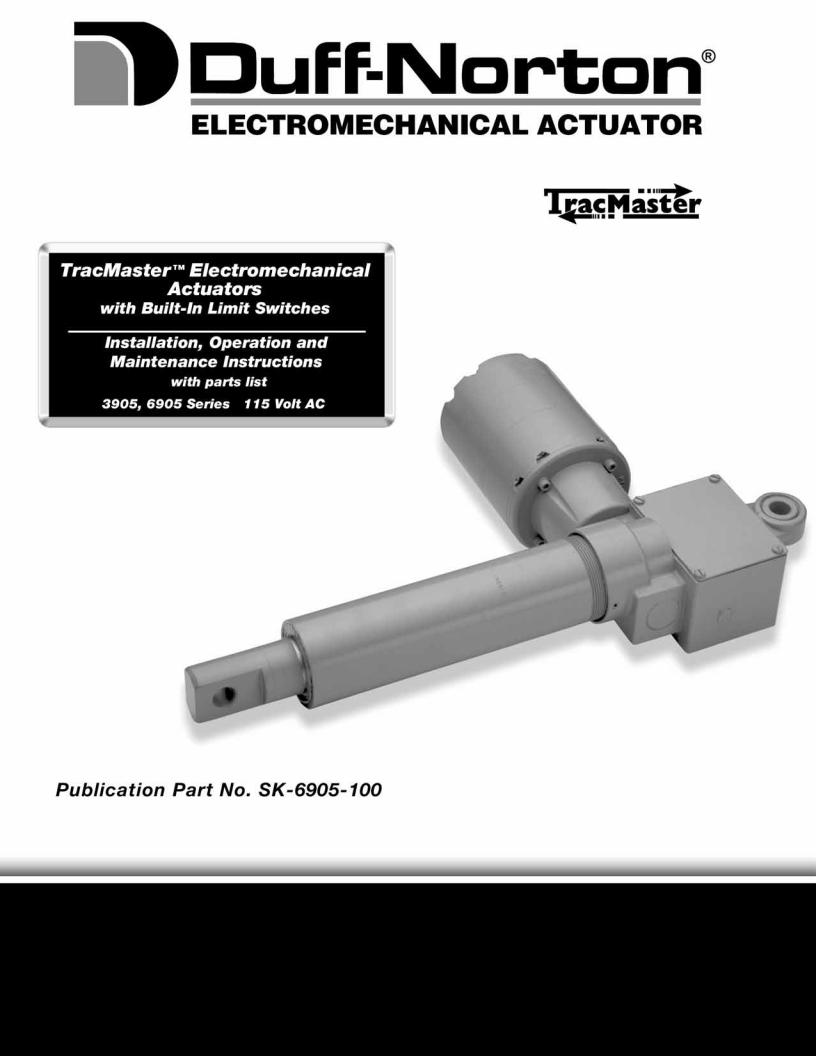Duff-Norton SK6905-100-1 User Manual

 CAUTION!
CAUTION!
This manual contains important information for the correct installation, operation and maintenance of the equipment described herein. All persons involved in such installation, operation, and maintenance should be thoroughly familiar with the contents. To safeguard against the possibility of personal injury or property damage, follow the recommendations and instructions of this manual and keep it for further reference.
 WARNING!
WARNING!
The equipment shown in this manual is intended for industrial use only and should not be used to lift, support, or otherwise transport people unless authorized in writing by Duff-Norton.

TABLE OF CONTENTS
|
|
PAGE |
SECTION I |
GENERAL INFORMATION |
|
1-1 |
General |
3 |
1-2 |
Industrial Use Only |
3 |
1-3 |
Factory Preparation |
3 |
1-4 |
Warranty |
3 |
FIGURE 1-5 |
Dimensions and Specifications |
4 |
SECTION II |
INSTALLATION |
|
2-1 |
Installation Procedures |
5 |
2-2 |
Limit Switch Cam Adjustment |
5 |
2-3 |
Potentiometer Installation |
5 |
2-4 |
Digital Position Indicator |
6 |
SECTION III |
OPERATIONAL PRECAUTIONS |
|
3-1 |
AC Motor |
7 |
3-2 |
Voltage Supply |
7 |
3-3 |
Clevis Pins |
7 |
SECTION IV |
MAINTENANCE |
|
4-1 |
Lubrication |
8 |
4-2 |
Required Tools |
8 |
4-3 |
General Procedures |
8 |
4-4 |
Disassembly |
8 |
4-5 |
Assembly |
9 |
SECTION V |
ILLUSTRATED PARTS LIST |
|
FIGURE 5-1 |
Exploded Illustration |
|
|
6905 Series AC Mini-Pac™ Actuator |
12 |
5-1 |
Parts List |
13 |
SECTION VI |
TECHNICAL ILLUSTRATIONS |
|
FIGURE 6-1 |
Limit Switch Wiring Diagram |
14 |
FIGURE 6-2 |
Limit Switch Assembly |
14 |
SECTION 1
GENERAL INFORMATION
1-1. General
This manual provides instructions for the installation, operation and maintenance of the Duff Norton® 3905 and 6905 Series AC Mini-Pac™ electromechanical actuator. It includes proper procedures for the disassembly, cleaning, inspection, rebuilding and assembly of the actuator. To ensure efficient, long, satisfactory use of this unit, these instructions should be followed closely.
1-2. Industrial Use Only
The actuators described and illustrated in this manual are intended for industrial use only and should not be used to lift, support or otherwise transport people, unless you have a written statement from Duff-Norton which authorizes this actuator unit, as used in your application, as suitable for moving people.
1-3. Factory Preparation
Each actuator is carefully assembled and tested at the factory to ensure that the motor and the mechanical components will function properly and that the actuator will lift its rated load.
The brake is preset at the factory and no further adjustment is required. With proper maintenance, this brake prevents the actuator from self-lowering.
The actuator is prelubricated at the factory and thus requires minimum maintenance.
Limit switches are checked at the factory for proper functioning.
The motor current draw is checked to make certain that it is within Duff-Norton standards.
Every effort has been made to deliver this unit in its factory-approved state. You should, however, carefully inspect the actuator for damage that may have occurred during transit.
1-4. Warranty and Warranty Repair
Subject to the conditions stated herein, Duff-Norton will repair or replace, without charge, any parts proven to Duff-Norton’s satisfaction to have been defective in material and workmanship. Claims must be made within one year after date of shipment. Duff-Norton will not repair or replace any parts that become inoperative because of improper maintenance, eccentric loading, overloading, chemical or abrasive action, excessive heat, or other abuse.
Equipment and accessories not of Duff-Norton’s manufacture are warranted only to the extent that they are warranted by their manufacturer, and only if the claimed defect arose during normal use, applications and service. Equipment which has been altered or modified by anyone without Duff-Norton’s authorization is not warranted by Duff-Norton. EXCEPT AS STATED HEREIN, DUFF-NORTON MAKES NO OTHER WARRANTIES, EXPRESS OR IMPLIED, INCLUDING WARRANTIES OF MERCHANTABILITY AND FITNESS FOR A PARTICULAR PURPOSE.
If you have any questions concerning warranty repair, please contact Duff-Norton.
Authorization for return must be received from Duff-Norton before returning any equipment for inspection or warranty repair.
3

115 V., 60 HZ, AC MOTOR
115 VAC Motor is enclosed, permanent split capacitor induction type. Load/no-load speeds are approximately equal. Equipped with thermal overload which opens and resets automatically. Standard motor requires 28-33 mfd capacitor or a 64-77 mfd capacitor for high speed motor (supplied by customer, or by Duff-Norton at
additional cost) for loads up to 500 pounds. A capacitor box is available to provide an enclosure for electrical connections and to give a convenient conduit installation.
FIGURE 1-5. DIMENSIONS AND SPECIFICATIONS
TABLE 1-1. WITH 115 V. 60 HZ AC MOTOR TABLE 1-2. DUTY CYCLE CHART
4

SECTION II
INSTALLATION
2-1. Installation Procedures
Use Figure 6.2 on page 14 as a guide to properly attach the actuator to your power source.
2-2. Limit Switch Cam Adjustment
IMPORTANT
Before attempting to set limit switch cams by these instructions, be certain that the red and black motor leads and the “Cam” and “Gear Cam” switch leads are connected to the proper capacitor terminals per Figure 6.2. Unless leads are connected exactly as shown, the following steps will be meaningless.
1.Set Retract Position
a.Do not connect translating tube to work piece at this time.
b.Energize and retract actuator until gear cam opens limit switch.
NOTE
Translating tube may have to jam and
spin prior to switch activation.
c.Unscrew the translating tube until the measured distance between the housing clevis hole centerline and the translating tube clevis hole centerline equals the desired closed height. If the mating clevis holes are not aligned, manually rotate the translating tube to align the clevises, this will be less than 180˚ rotation and the closed height of the actuator will then be within 1/4” of the desired retracted dimension.
d.Pin the translating tube clevis in place and energize the actuator to check the drift.
2.Set Extend Position
a.Restrain the translating tube from turning, operate actuator and extend to desired position.
b.Adjust steel switch cam until switch is activated allowing for drift. (This is accomplished by loosening socket head set screw until cam rotates with a slight drag on the shaft when the Allen wrench is used as a lever.)
c.Check travel and readjust if necessary.
d.Socket head set screw on cam should be tightened after final adjustment is made. Do not strip threads by overtightening.
At maximum load, repeatability is 1/8” in either direction including drift and normal wear of parts.
FOR UNITS WITH
POTENTIOMETER
2-3. Potentiometer Installation
1.Loosen pot locknut and remove from actuator.
2.For best accessibility, solder leads to pot at this time.
3.Limit switches should be set for extreme limits of travel per instructions. Limit switch cam adjustments should be made per paragraph 2 prior to potentiometer installation.
 CAUTION
CAUTION
Do not engage potentiometer shaft gear teeth with plastic worm before reading the following procedure. Failure to adhere to the following procedure could cause damage to the potentiometer.
4.Retract actuator translating tube until stopped by limit switch.
5.a. For travels up to 9” (single turn pot):
i.Turn pot shaft counterclockwise until resistance between terminal S and CCW is approximately 100 ohms. This will be the pot’s full retracted position.
ii.Being careful not to turn the pot shaft, slide it into engagement with the plastic worm and tighten locknut.
iii.Re-check resistance. If necessary loosen locknut slightly and twist pot to re-establish 100 ohm resistance. Pot does not have end of travel stops, but has a 20˚ deadband between the two ends of the resistive element. No continuity will be measured to terminal S if the slider is in the deadband.
iv.Run actuator to full extension (do not let tube rotate) until it is stopped by its limit switch.
v.Check resistance between S and CCW to be sure the slider is still on the element and the resistance is greater than 100 ohms. The pot has enough rotation for 9.43 inches of
5
